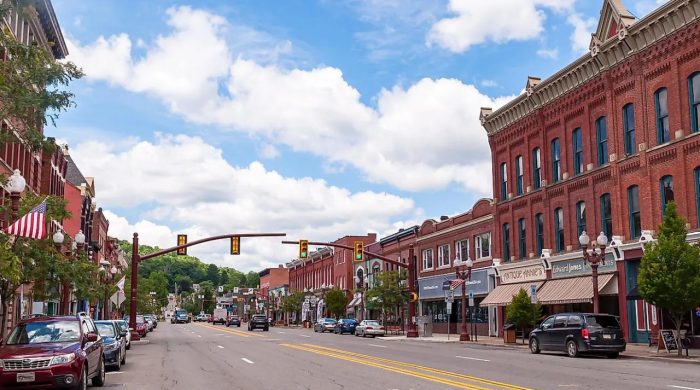Michigan: People Are Leaving These Cities and Flocking to These

- Update Time : Thursday, January 4, 2024
- 48 Time View

Michigan is a state with a rich history, diverse culture, and natural beauty. However, not all of its cities are equally attractive to residents and newcomers. Some cities are experiencing population decline, while others are seeing growth and development. What are the factors that influence people’s decisions to move in or out of a city? And which cities are the most and least popular destinations in Michigan?
Population Trends in Michigan
According to the U.S. Census Bureau, Michigan’s population increased by 0.1% from 2010 to 2020, reaching 10,077,331 people. However, this growth rate was lower than the national average of 7.4% and ranked 43rd among the 50 states. Moreover, the population change was not evenly distributed across the state. Some cities gained more residents, while others lost them.
The Census Bureau also released the estimates of population change for cities and towns with at least 5,000 people from 2010 to 2019. Based on these estimates, the top five cities that gained the most population in Michigan were:
- Grand Rapids (+11,412)
- Ann Arbor (+8,449)
- Detroit (+6,559)
- Kalamazoo (+5,544)
- Novi (+5,411)
On the other hand, the top five cities that lost the most population in Michigan were:
- Flint (-10,036)
- Saginaw (-5,690)
- Taylor (-4,538)
- Westland (-4,120)
- Pontiac (-3,958)
Reasons for Moving In or Out of a City
There are many factors that can influence people’s decisions to move in or out of a city, such as economic opportunities, quality of life, affordability, safety, education, health, and social connections. Some of these factors are more important than others, depending on the individual’s preferences and circumstances. However, some general trends can be observed from the data and research.
Economic Opportunities
One of the main reasons for moving to a city is to find better economic opportunities, such as jobs, income, and business growth. According to the Bureau of Labor Statistics, the unemployment rate in Michigan was 5.0% in February 2021, lower than the national average of 6.2%. However, this rate varied by city, ranging from 2.9% in Ann Arbor to 9.0% in Flint.
The cities that gained the most population in Michigan also had higher median household incomes and lower poverty rates than the state average, according to the U.S. Census Bureau. For example, the median household income in Novi was $94,576 and the poverty rate was 5.4%, compared to the state average of $59,584 and 13.0%, respectively. On the other hand, the cities that lost the most population in Michigan had lower median household incomes and higher poverty rates than the state average. For instance, the median household income in Pontiac was $32,049 and the poverty rate was 33.4%.
Additionally, the cities that gained the most population in Michigan also had more diverse and dynamic economies, with a mix of industries and sectors that offered various employment and entrepreneurial opportunities. For example, Grand Rapids was ranked as the 13th best place for business and careers by Forbes in 2019, due to its strong manufacturing, health care, education, and tourism sectors. Similarly, Ann Arbor was ranked as the 6th best place for business and careers by Forbes in 2019, due to its high-tech, biotech, and research and development sectors.
Quality of Life
Another reason for moving to a city is to enjoy a better quality of life, which can include aspects such as amenities, culture, recreation, environment, and community. According to the U.S. News & World Report, the cities that gained the most population in Michigan also had higher rankings for quality of life than the state average, based on metrics such as crime, health care, education, well-being, and social capital. For example, Detroit was ranked as the 55th best place to live in the U.S. in 2020, due to its revitalization, diversity, arts, and sports scenes. Likewise, Kalamazoo was ranked as the 64th best place to live in the U.S. in 2020, due to its affordability, education, culture, and nature.
On the contrary, the cities that lost the most population in Michigan had lower rankings for quality of life than the state average, according to the U.S. News & World Report. For instance, Flint was ranked as the 125th best place to live in the U.S. in 2020, due to its ongoing water crisis, crime, poverty, and health issues. Similarly, Saginaw was ranked as the 123rd best place to live in the U.S. in 2020, due to its economic decline, violence, and lack of amenities.
Conclusion
In conclusion, Michigan is a state with diverse and dynamic cities that attract or repel residents and newcomers based on various factors. The cities that gained the most population in Michigan were Grand Rapids, Ann Arbor, Detroit, Kalamazoo, and Novi, which offered better economic opportunities and quality of life than the state average. The cities that lost the most population in Michigan were Flint, Saginaw, Taylor, Westland, and Pontiac, which suffered from lower economic opportunities and quality of life than the state average. These trends reflect the preferences and circumstances of people who seek to improve their lives by moving to a city that suits their needs and aspirations.

























